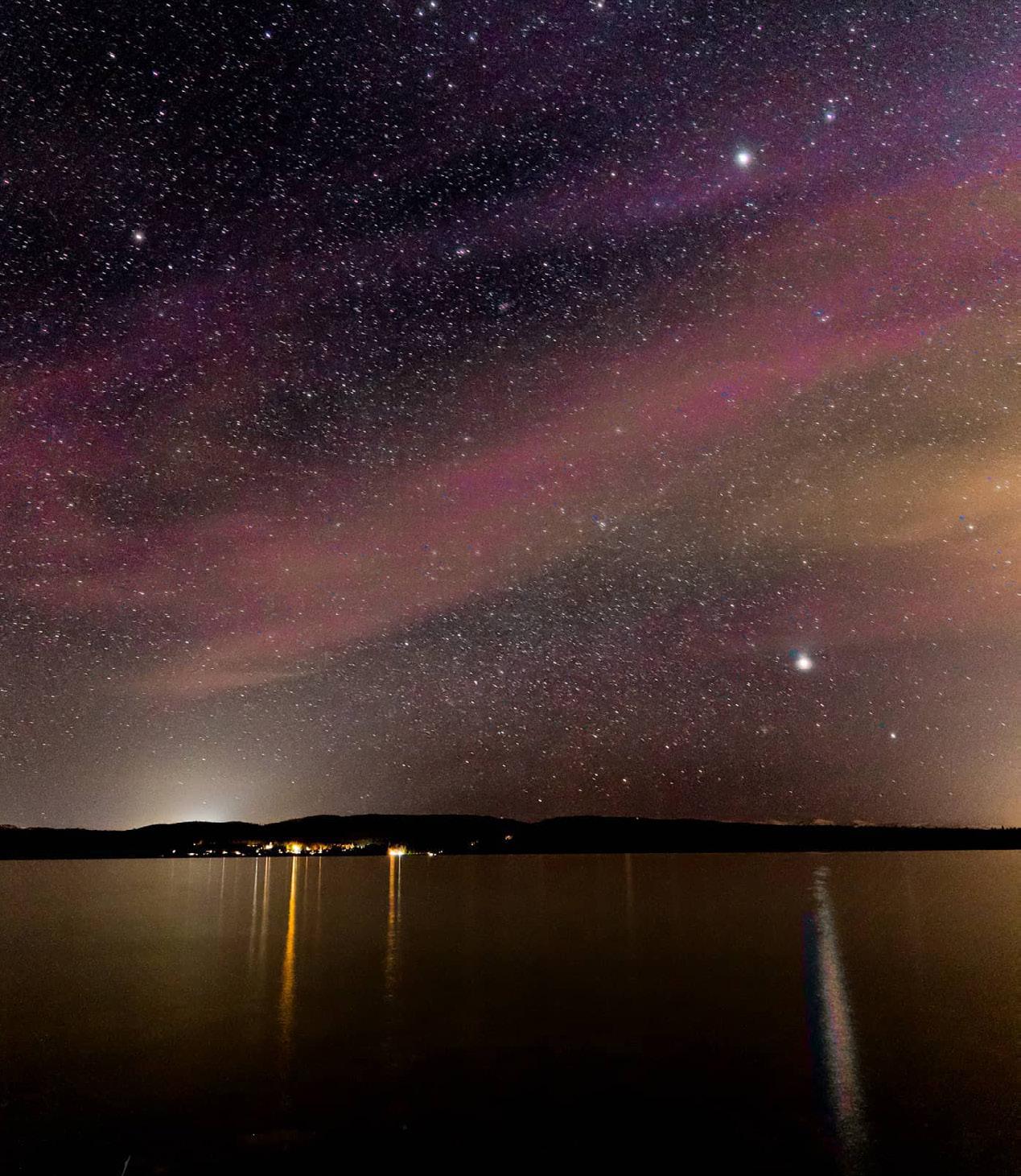
7 minute read
Chase Auroras this summer
NIGHT SKIES ARE STILL OPEN DURING COVID:
ABOVE: “Western Lights,” Carl Anderson’s image of Powell River lights reflecting off clouds, and a billion stars, photographed from the Airplane Park. TOP THREE, RIGHT: Carl’s images of the Aurora Borealis over Mowat Bay April 16. BOTTOM FAR RIGHT: Doris Guevara-Isert’s image of Noctilucent clouds RIGHT: The comet NEOWISE over qathet in summer 2020, as photographed by Doris. Watch for newly-discovered Comet Leonard as it passes in December 2021.
Advertisement
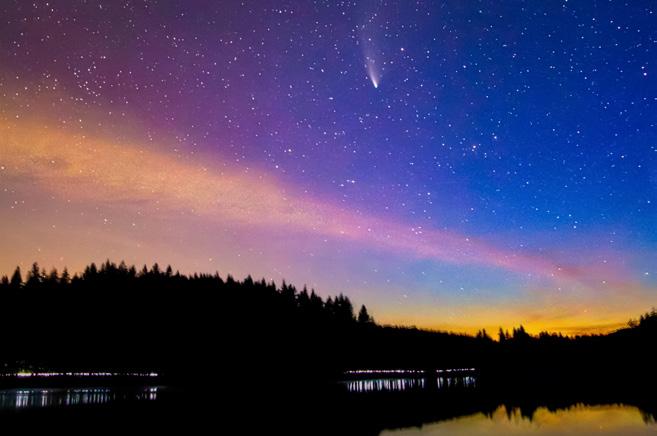
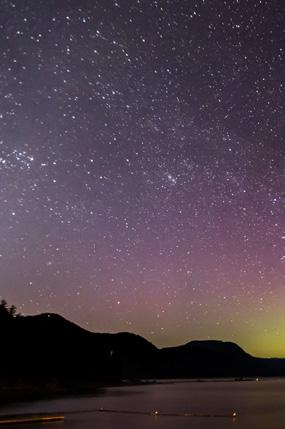
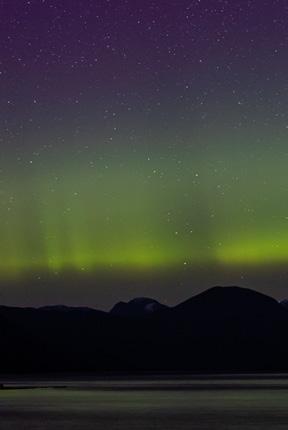
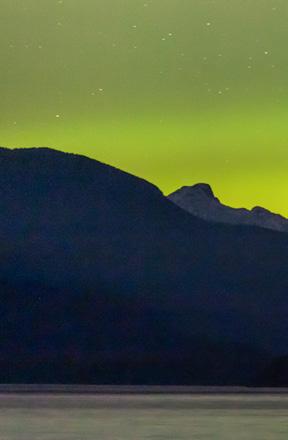

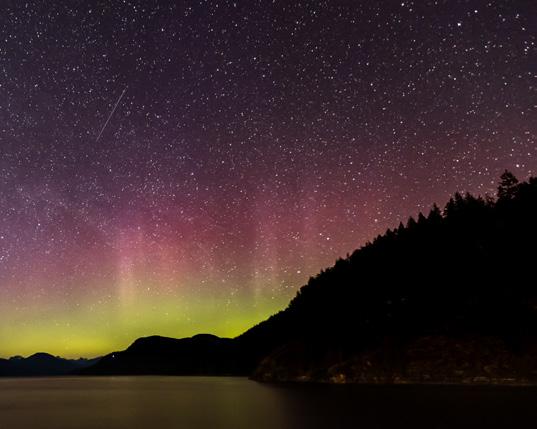
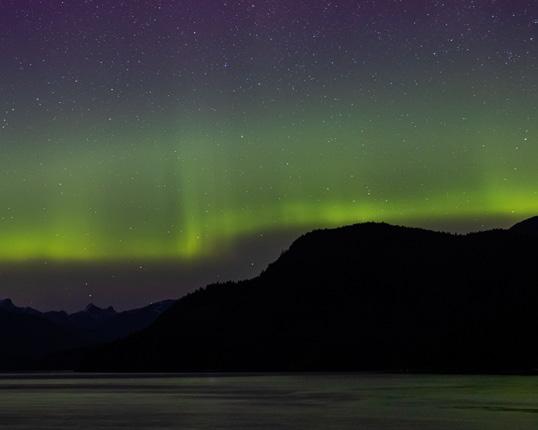
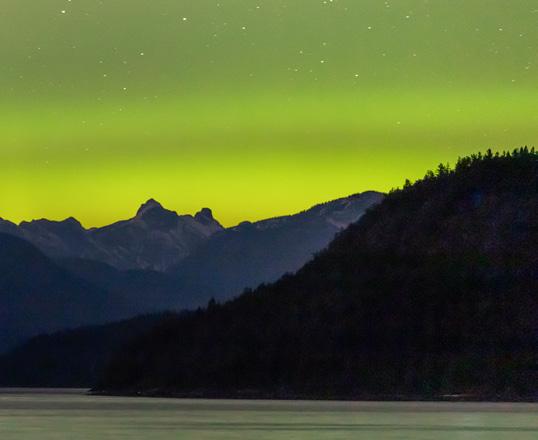
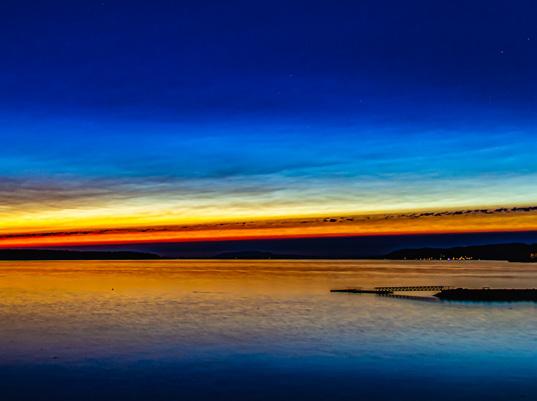
More auroras coming here... maybe
“Geeky” squad captures rare vibrant Northern Lights
BY PIETA WOOLLEY
At 8:30pm on April 16, Doris Guevara-Isert’s phone binged. Her app, Aurora Borealis Forecast and Alerts, showed a minor solar storm on the way, and that it may be strong enough to be visible in qathet.
Doris and her group of fellow night sky photographers started messaging each other; they’d been burned before by alerts like these. Seeing an aurora here is very rare. Since moving from Costa Rica in 2013, the industrial engineer has seen them twice – both three years ago. Auroras are normally visible much further North, or South.
Plus, the coastal rainforest has its own unique impediments. Here, when a solar storm results in a KP index of 6 or greater, enough activity to see the lights, it’s often overcast. When skies are clear, Doris said, invariably the KP index is low.
However, qathet’s most distinct advantage is the lack of light pollution. True dark.
Soon after that “bing,” group member Carl Anderson sent a photo of some very faint green lights over Mowat Bay.
“Then everyone went crazy,” said Doris.
The astrophotography group, which includes regulars Carl, Rhondda Schreurs, Jennifer Salisbury, Curt Tweedle and others, met at the beach at 10pm. The pulsating lights brightened.
“We were all screaming and shouting. We are really geeky. We laugh at ourselves so much.”
After Doris saw the lights three years ago, she invested in a couple of wide-angle astrophotography lenses for her Canon 60D. Since then, she shot last summer’s visit by the NEOWISE comet, noctilucent clouds, the annual meteor showers, the Milky Way, and more. This was her first aurora.
“I got home at midnight. I was just vibrating.”
Not bad for a Friday night in COVID-closed qathet. In fact, Doris and her buddies have a full summer of socially-distanced, outdoor events planned (see next page). For Doris, it’s a chance to leave her home and pursue an otherworldly passion; she has been homeschooling her kids since last March, protecting a child and her husband who are immuno-compromised. (Sometimes she brings her kids, aged 13 and 6. They often fall asleep in the car before anything is visible.)
For anyone who’s feeling trapped by the newest health orders, or like the days are stretching into the horizon with no fun to look forward to, simply looking up may be a cure.
During the day, you can find Carl Anderson fixing the electronic patient care devices at the hospital – the ventilators, dialysis machines, monitors and more. He and his family have, like the rest of us, been socially-isolating for over a year. So when the auroras brightened local skies mid-April, they lit him up, too.
“We don’t get them often,” said Carl, a biomedical engineering technologist. “It’s so rare that we get them as intense as what we saw on Friday. Most of the time what we see is very faint vertical bands. I posted my pictures on Facebook, and other people got really excited. The next night, the aurora didn’t show up. So I felt embarrassed–like I’ve promised someone something. They don’t always show up.”
Carl admits that photographing celestial events, especially in the winter, is a lot of standing still behind a tripod in the middle of the night, freezing.
But, sometimes the best images are not apex events. On April 12 at the Airplane Park in Grief Point, he snapped an image he calls “Western Lights,” a tonguein-cheek reference to the Northern lights. Over Texada, he had planned to shoot the Milky Way, which becomes more visible through the summer.
“It hadn’t been clear in weeks,” he said. “We also hoped to take pictures of Orion and the phosphorescence, which was not out. I was not very successful with that. But I took this interesting long exposure image – it’s 10 three-second exposures combined to give you this effect (far left). You’re seeing the light being reflected from the city behind us in the clouds. They were ruining my photo until I played with them.”
The group usually meets twice a week to shoot, but much more often if there’s a comet or meteor shower. Carl advises that the best way to learn astrophotography is to just go out and do it. Digital cameras mean there’s no limit to the number of frames you can shoot (though he does say the group knows it’s time to go home when the camera cards are full, or the batteries have died.) Google, YouTube and apps all offer vast amounts of advice.
This summer, Doris, Carl and the rest of the “geeky” group are looking forward to the Milky Way brightening, the Perseid meteor shower in August, and noctilucent clouds – 50-mile-high, rippling, blue phenomenon of space dust meeting the earth’s warm moist air–which appear in summer after sunset.
“I’m really looking forward to not freezing,” says Carl.
Six celestial events to chase this year
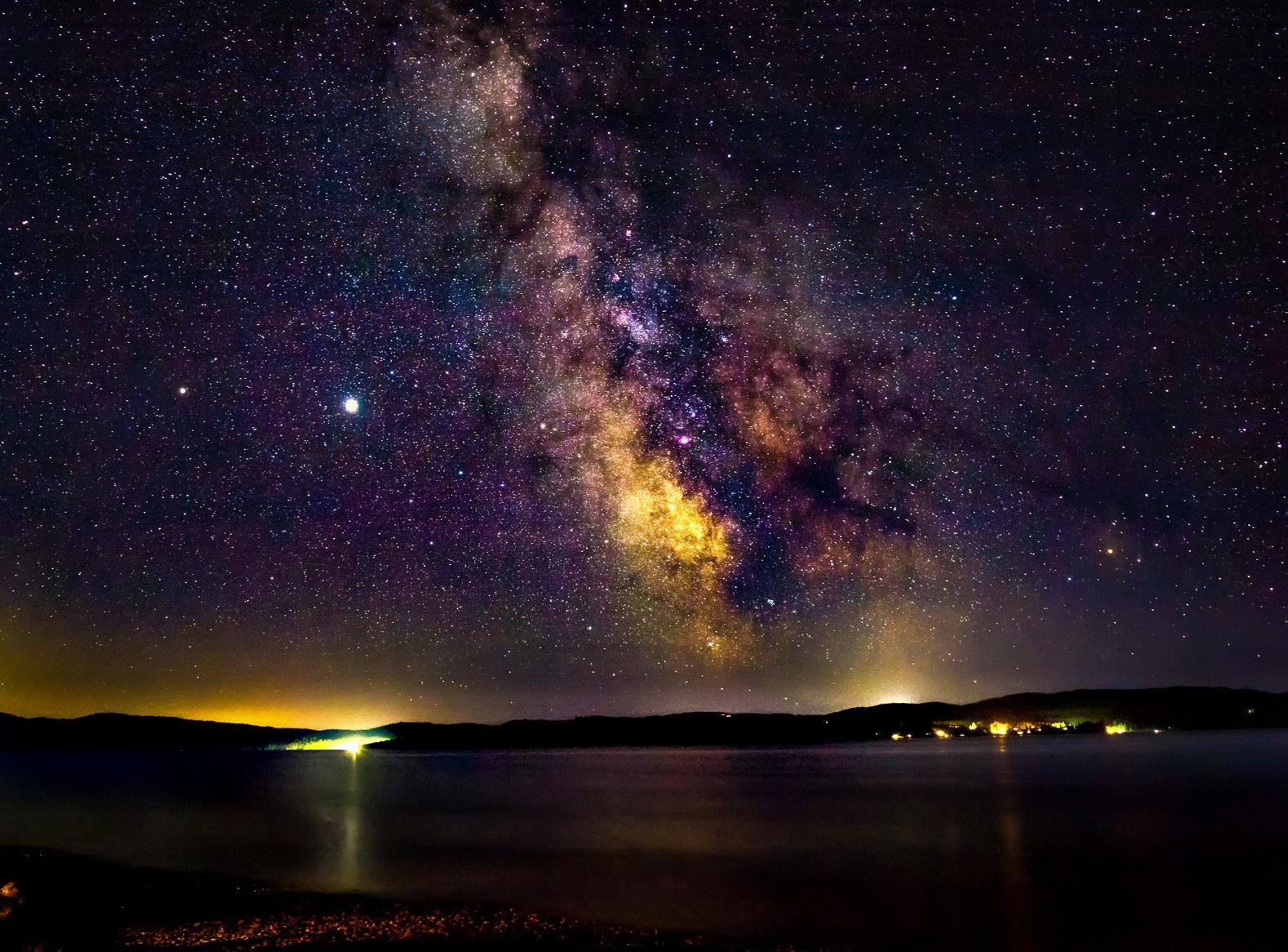
MILKY ABOVE, MILKY BELOW: Where the milky white herring spawn and the Milky Way Galaxy meet.
BY DORIS GUEVARA-ISERT
Milky Way Season
When: The core (the brightest part of the MW) is visible in our northern hemisphere from March to October. The best time is summer when it stays visible longer during the night. There are free apps like Stellarium or Starwalk, that can tell you the time the core rises on the horizon and where to look for it.
Where: Anywhere dark or with low light pollution, and a clear view that is SW-oriented in town. I like Grief Point or Beach Gardens. We are very lucky in Powell River to have places relatively close to town that are Class 2 on the Bortle Scale, like Duck Lake, or Class 1 like Savary Island and Stillwater. This is a scale to measure light pollution, the lower the number, the darker the skies, which is ideal for stargazing.
Blood Moon Eclipse
When: Wednesday, May 26. The full moon will drift through the earth’s shadow, and appear red. It will also appear bigger than normal, as it’s the moon’s perigee–the closest the moon will get to Earth this month.
Aurora Borealis
The sun is coming out of a very quiet period of solar activity that lasted 11 years and is promising stronger auroras.
When: They are directly dependent on solar activity (solar flares and geomagnetic storms). In our middle latitudes, they are hard to see with the naked eye. The best chance to see them is when we have clear skies and a G2 or G3 storm is hitting the earth. Free apps can alert you when this is to happen.
Where: Find a clear views North, and dark skies, such as Mowat Bay.
Meteor Showers
When: There are many during the year. The most significant are the Perseids on August 11-12 (Visible NE at predawn) and the Geminid on December 13-14 (Visible NE all night).
NLC Clouds Season
This is one of my favorite phenomena to chase. Noctilucent clouds are the highest clouds in our atmosphere and very rare to spot. They shine by reflecting the sun’s light when the temperatures on the Mesosphere are extremely cold. The first time I saw them was in Cambell River. Only visible from 50 to 70 degrees Latitude and when the sun is between 6-16 degrees below the horizon (after sunset/before sunrise).
When: May through August.
Where: Anywhere SW to NW oriented, such as the Seawalk or Mowat Bay.
Photo by Doris Guevara-Isert
Comet Leonard
This is a newly discovered comet and is promising to be the brightest of 2021.
When: Its closest approach will be December 12, 2021. It may be visible to the naked eye before sunrise, during December, below the Ursa Major Constellation.
See more images:
Carl Anderson • seaforestphotography. myportfolio.com Doris Guevara • Doris Guevara Photography @dorismguevara on Instagram




